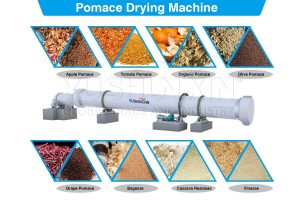As industries seek sustainable solutions for organic waste, the transformation of pomace—such as fruit and vegetable residues—into high-quality organic fertilizer presents a promising opportunity. However, the procedure for pomace drying introduces several technical challenges. Understanding these obstacles and selecting appropriate drying machinery can significantly improve the efficiency and quality of fertilizer manufacture.
What Types of Pomace and Organic Wastes Are Suitable for Fertilizer Granulation and What Benefits Do They Offer?
Different industries generate diverse forms of high-moisture organic waste, including apple pomace from juice processing, grape marc from wineries, olive residue from oil extraction, and vegetable pulp from food manufacturing. These raw materials typically exhibit moisture contents above 85%, which poses a challenge for direct use in fertilizer granulation or pelletizing processes. In addition, the composition of pomace can vary, affecting the nutrient profile and physical properties of the resulting organic fertilizer particles.
Each sector benefits from converting pomace into fertilizer: the fruit juice industry can reduce disposal costs, the wine industry can decrease environmental impact, and vegetable processors can achieve resource recycling goals. Pomace fertilizer production uses granulation, pellet making, and composting procedures to turn waste into valuable products for soil improvement and crop support. The proper preparation and granulating of organic fertilizer from pomace not only addresses waste management but also closes the loop in agricultural and food manufacturing systems.

What Are the Main Obstacles in Pomace Water Reduction for Fertilizer Pelleting and How Can You Address Them?
The transformation of wet pomace into stable, storable fertilizer granules or pellets involves overcoming significant challenges in moisture reduction. Pomace often arrives with moisture levels above 90%, which hinders direct composting, granulation, or pelletizing and risks causing microbial spoilage during storage. Additionally, excessive water content in the granulating stage can lead to clumping, poor particle shape, and low mechanical strength in the finished fertilizer pellet or granule.
To address these issues, a systematic approach to water removal is required. The process generally consists of four main stages: dewatering with a mechanical dewatering machine to rapidly lower surface moisture; composting to stabilize organic matter and further evaporate water; wet granulation or pelletizing with a granulator or pelletizer to form initial particles; and precision drying with a specialized pomace drying machine to reach final moisture levels below 10%. Each step ensures the organic fertilizer production process delivers uniform, durable, and easily storable granules, meeting industry requirements.
How Do Drum Dryers and Other Key Machines Contribute to Efficient Pomace Fertilizer Production?
To optimize moisture reduction in pomace fertilizer manufacturing, the selection of reliable machinery, especially for drying, plays a crucial role. Drum dryers offer continuous, efficient water removal from granulated or composted pomace, ensuring consistent final moisture content. Their robust design handles a variety of pomace materials and particle sizes, supporting both small-scale pellet making systems and large-scale granulation lines.
In addition to the drum dryer, essential equipment such as dewatering machines and compost turners prepares the pomace for subsequent granulation. Wet granulators or pelletizers shape the organic waste into granules or pellets suitable for fertilizer application. Together, these machines form an integrated system for pomace fertilizer production, maximizing throughput and product quality during each stage of the process.
What Practical Solutions Help Overcome Drying and Granulation Challenges in Pomace Fertilizer Manufacturing?
A comprehensive pomace fertilizer production process must balance energy usage, product uniformity, and operational reliability. Proper machine selection, such as choosing a high-efficiency drum dryer, directly affects drying speed, moisture control, and granule quality. Integrating dewatering and composting steps before granulation or pellet making further optimizes water reduction and organic matter stabilization.
Many industries rely on professional drying equipment manufacturers to customize solutions for their organic fertilizer granulation or pelletizing needs. For example, a system designed by Yushunxin offers robust drum dryer machinery and supporting equipment for pomace drying, ensuring effective water reduction at every stage. By addressing each technical challenge—dewatering, composting, granulation, and drying—industries can achieve cost-effective, sustainable fertilizer manufacturing from high-moisture pomace.
Conclusion
In summary, pomace fertilizer production presents multiple moisture reduction challenges, from dewatering and composting to granulation and drying. Selecting and integrating advanced drying machines, particularly drum dryer equipment, enables efficient transformation of wet pomace into high-quality fertilizer pellets or granules. By implementing a well-designed procedure, industries ensure consistent product performance and contribute to a circular economy. For tailored solutions in pomace drying and organic fertilizer manufacturing technology, a professional equipment manufacturer like Yushunxin offers reliable support and expertise. You can visit: https://www.fertilizerdryer.com/pomace-drying-machine/